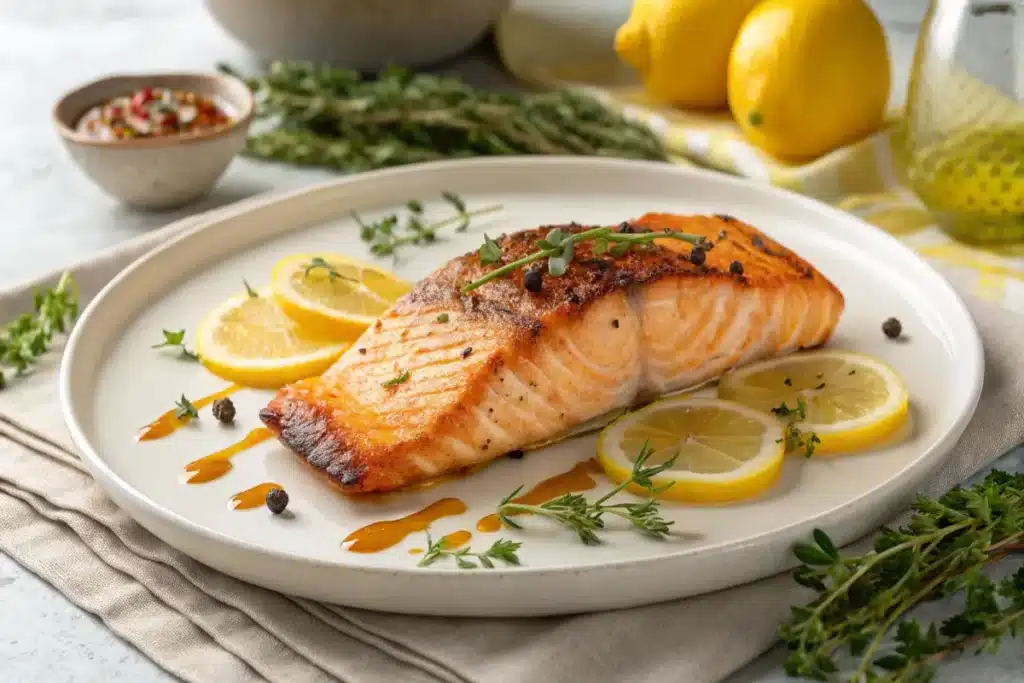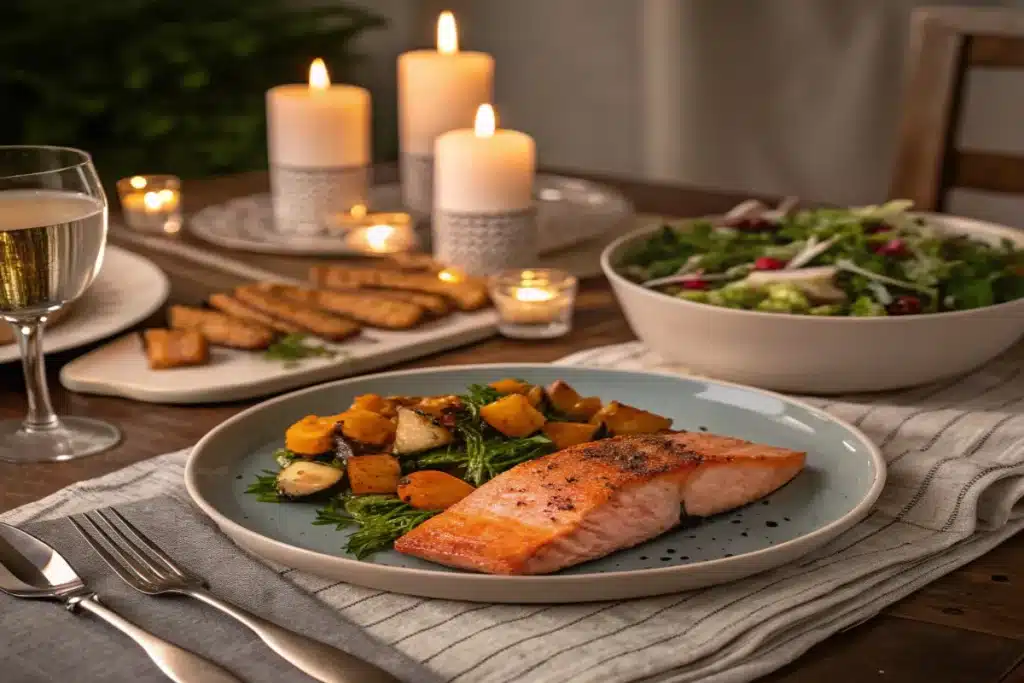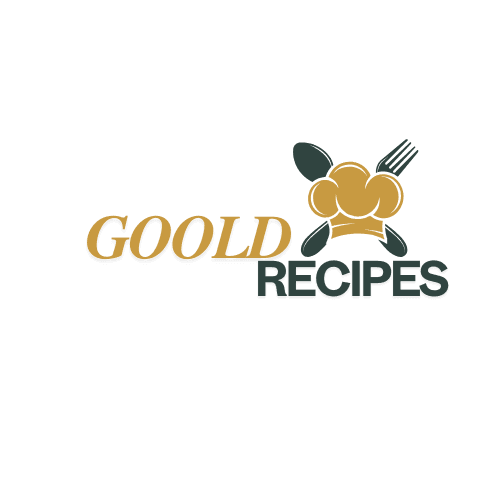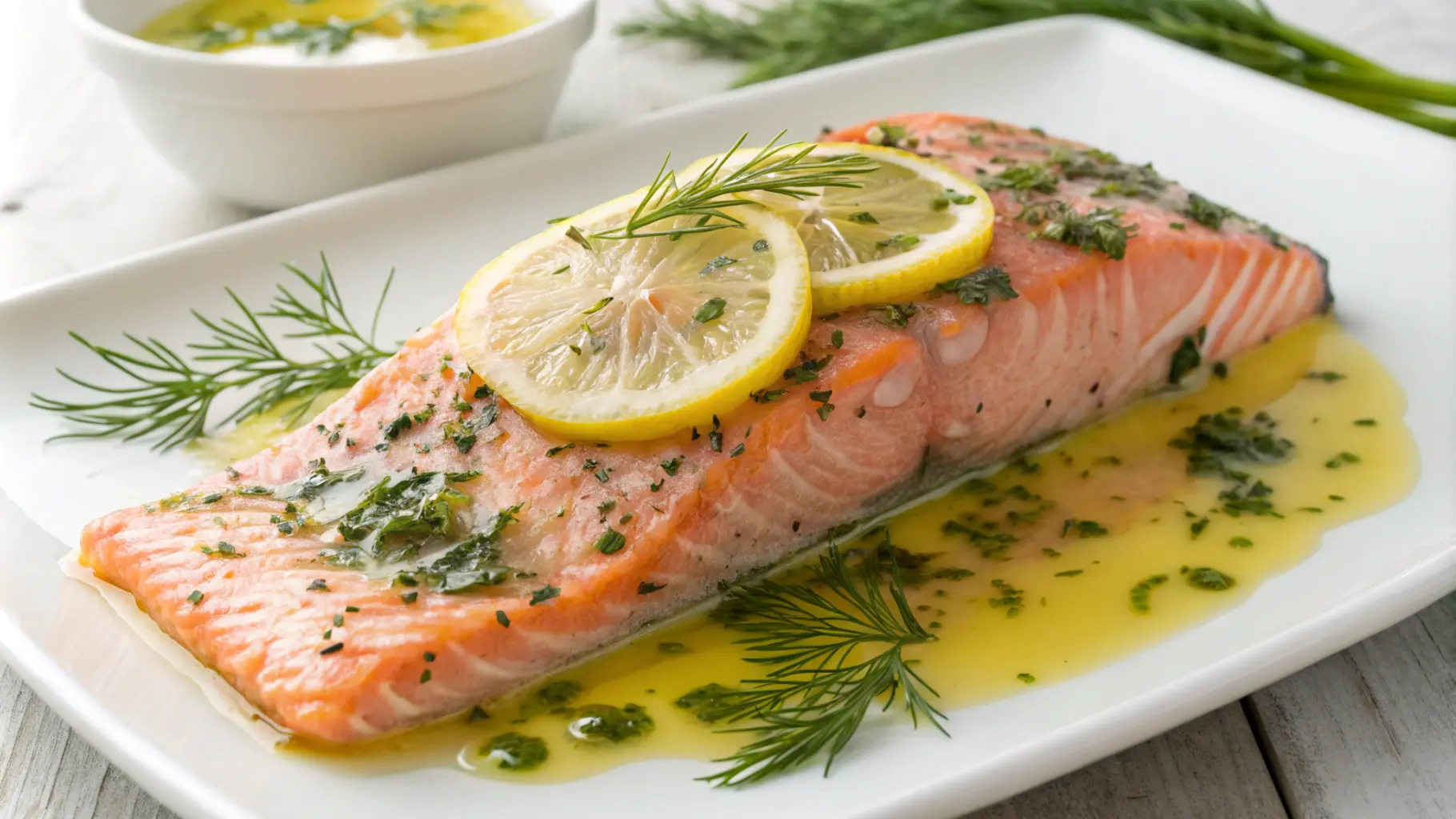
introduction
1.1 Nutritional Benefits of Mastering King Salmon
Mastering King Salmon, also known as Chinook salmon, stands out as one of the most nutrient-packed fish available. First and foremost, it is a powerhouse of omega-3 fatty acids, which are known to support heart health, reduce inflammation, and boost cognitive function. A single serving also provides high-quality protein essential for muscle repair and growth, along with vitamins B12, D, and selenium, which are crucial for overall well-being.
In addition to these benefits, King salmon boasts low mercury levels compared to other seafood, making it safer for frequent consumption. Ultimately, its nutrient profile aligns perfectly with diets aimed at improving cardiovascular health and immunity. For further details, check out this comprehensive guide on mastering King Salmon.
Looking for more seafood inspiration? Check out these shrimp and scallop recipes
Table of Contents
Table of Contents
2.Prepping King Salmon for Cooking

1.2 Flavor Profile and Texture of King Salmon
The buttery texture and rich, umami flavor of King salmon set it apart from other varieties. Its meat is both tender and firm, offering a satisfying balance between flakiness and moisture. Moreover, its high-fat content ensures that it remains succulent, no matter how it is cooked—whether grilled, baked, or smoked.
Additionally, this luxurious flavor complements a wide range of seasonings. For a lighter touch, pair it with lemon and dill. For those who enjoy bold flavors, options like Cajun spices or a miso glaze work beautifully.
1.3 Regional Variations and Sources of King Salmon
King salmon is predominantly sourced from the Pacific Northwest, with Alaska being the leading supplier. Interestingly, wild-caught varieties, such as those from the Copper River, are often celebrated for their superior taste and texture. On the other hand, farm-raised salmon is available year-round and provides a consistent flavor, though it may differ slightly in texture.
As you might expect, sustainability is an important consideration when sourcing King salmon. To ensure you’re making an eco-conscious choice, look for certifications like the Marine Stewardship Council (MSC) or explore resources like Seafood Watch.
3. Choosing the Right Cooking Method
3.1 Factors to Consider: Freshness, Cuts, and Preferences
Undoubtedly, the freshness and cut of your King salmon will influence the cooking method. For instance:
- Filets: Perfect for grilling, pan-searing, or baking due to their thinner profile.
- Steaks: Thicker cuts are best suited for grilling or frying as they retain their structure better during cooking.
Furthermore, your personal preferences—whether you prefer crispy skin, a smoky flavor, or a quick preparation—should guide your choice.
3.2 Balancing Texture and Moisture in Cooking
Moisture retention is key when preparing King salmon, as it ensures the signature flakiness and richness of the fish. To achieve this:
- First, use moderate heat to cook the salmon evenly.
- Additionally, consider basting with butter, broth, or marinade throughout the process to prevent dryness.
3.3 Cooking Methods for Health-Conscious Eaters
For those focused on healthy eating, certain techniques are better suited to preserving salmon’s nutrients:
- Baking: Uses minimal oil, making it both health-conscious and convenient.
- Poaching: Gentle and ideal for locking in moisture and nutrients.
- Sous Vide: Offers precise temperature control for perfectly cooked fish every time.
No matter the method, health-conscious diners can enjoy King salmon guilt-free.
Don’t miss our ultimate guide to cooking king salmon for even more pro tips
4. Grilling King Salmon: An All-Time Favorite
4.1 Best Tools and Equipment for Grilling
To grill King salmon effectively, the right tools make all the difference. Specifically, you’ll need:
- A charcoal or gas grill for even heat.
- Non-stick grill mats or oiled grates to prevent sticking.
- A fish spatula for flipping without breaking the filet.
4.2 Step-by-Step Grilling Instructions
Follow these steps to master grilled King salmon:
- Preheat the grill to medium-high heat.
- Brush the salmon with olive oil and season with salt and pepper.
- Place the salmon skin-side down and cook for 4–6 minutes per side.
- Use a thermometer to confirm the internal temperature reaches 145°F.
Finally, let the salmon rest for 2–3 minutes before serving to allow the juices to redistribute.
5. Pan-Seared King Salmon: A Quick and Elegant Option

5.1 Why Pan-Seared Salmon is Popular
Pan-searing is one of the most popular methods for preparing King salmon, thanks to its simplicity and elegance. Not only does this method create a beautifully crispy golden crust, but it also locks in the fish’s natural moisture. Moreover, pan-searing is quick and adaptable, making it perfect for weeknight dinners or sophisticated meals.
In addition to its efficiency, this technique allows for endless versatility in seasoning, from light herb blends to bold, spicy rubs.
5.2 Achieving the Perfect Golden Crust
To achieve that coveted golden crust, it’s essential to follow these steps carefully:
- Pat the salmon dry with a paper towel to remove any excess moisture.
- Heat oil (such as olive or avocado oil) in a non-stick skillet until shimmering.
- Place the salmon skin-side up in the pan and avoid moving it for 3–4 minutes. This ensures the crust forms evenly.
- Flip the salmon gently and cook for another 2–3 minutes, depending on thickness.
Finally, let the salmon rest briefly before serving to allow the juices to redistribute.
5.3 Complementary Sauces for Pan-Seared King Salmon
A well-chosen sauce can elevate the flavors of pan-seared salmon. Consider these options:
- Lemon Butter Sauce: A classic choice that adds brightness and richness.
- Mango Salsa: A refreshing and tropical pairing perfect for summer.
- Pesto Drizzle: An earthy, herbaceous option that enhances the fish’s natural flavors.
By pairing pan-seared salmon with a complementary sauce, you can create a dish that feels both indulgent and balan
6. Baking King Salmon: Low-Effort Perfection
6.1 Oven Preparation and Temperature Tips
Baking is one of the simplest ways to cook King salmon. First, preheat your oven to 375°F. Then:
- Line a baking sheet with parchment paper or foil for easy cleanup.
- Lightly grease the surface to prevent sticking.
- Season the salmon and, if desired, cover loosely with foil to retain moisture.
6.2 Foil-Wrapped vs. Open-Baked Techniques
When baking, there are two main techniques to consider:
- Foil-Wrapped: This method locks in steam, yielding moist and tender salmon.
- Open-Baked: Allows for a crispier exterior, particularly when broiled briefly at the end.
7. Poaching King Salmon: A Healthy Choice
7.2 Maintaining Ideal Temperatures During Poaching
To poach salmon effectively, keep the liquid at a gentle simmer, not a boil, maintaining 160–180°F. Submerge the salmon completely and cook for 8–10 minutes depending on its thickness. This method preserves both moisture and nutrients.
8. Smoking King Salmon: For a Gourmet Touch
8.1 Cold-Smoking vs. Hot-Smoking: What’s the Difference?
Smoking King salmon is an excellent way to elevate its flavor, offering a rich, smoky taste that works perfectly for special occasions. When deciding how to smoke your salmon, it’s essential to understand the two main techniques available:
- Cold-Smoking: This method preserves the fish without actually cooking it, resulting in a silky texture. Because of this, cold-smoked salmon works wonderfully for dishes like bagels, salads, or charcuterie boards.
- Hot-Smoking: In contrast, this method fully cooks the salmon, producing a flaky texture. As a result, it’s ideal for hearty main courses, pasta dishes, or casseroles.
Ultimately, the choice between cold-smoking and hot-smoking depends on your desired outcome. While both techniques highlight the versatility of smoked salmon, it’s important to note that cold-smoked salmon tends to have a more delicate flavor, whereas hot-smoked salmon delivers bolder, heartier notes.
8.2 Equipment and Tools for Smoking Salmon
To achieve professional-quality smoked salmon, having the right tools is crucial. Before getting started, make sure you gather the following essentials:
- A smoker or charcoal grill equipped with a smoking box. This is vital for creating the controlled environment necessary to infuse the fish with smoky flavor.
- Hardwoods like alder or hickory. Not only do these woods pair beautifully with salmon, but they also impart a mild yet aromatic flavor that complements the fish without overwhelming it.
- A thermometer to monitor the internal temperature of the salmon. For hot-smoking especially, it’s important to ensure the fish reaches a safe 145°F while cooking.
Additionally, preparation is key when smoking salmon. For instance, soaking wood chips in water beforehand can help them smolder longer, creating more consistent smoke. By paying attention to these details, you’ll be well on your way to mastering the art of smoking salmon.
Once your setup is ready, smoking salmon becomes a rewarding culinary adventure.
8.3 Preserving the Smoky Flavor in Storage
Smoked salmon can be stored for extended periods while retaining its gourmet flavor. To ensure freshness:
- Store in an airtight container in the refrigerator for up to one week.
- For longer storage, vacuum-seal and freeze the salmon for up to three months.
When thawing, do so gradually in the fridge to preserve its delicate texture and smoky notes.
9. Sous Vide King Salmon: Precision Cooking
9.1 Understanding the Sous Vide Technique
Sous vide, which means “under vacuum” in French, is a precision cooking technique that guarantees evenly cooked and tender salmon. Essentially, the fish is vacuum-sealed and immersed in a water bath held at a precise temperature. This method is particularly useful for King salmon, as it locks in moisture and enhances its rich flavor.
9.2 Choosing the Right Temperature and Time
For best results, adjust the sous vide temperature based on your preferred level of doneness:
- Medium-Rare: Set the water bath to 125°F (51°C) and cook for 45 minutes.
- Medium: Increase the temperature to 135°F (57°C) for a slightly firmer texture.
Ultimately, the sous vide process ensures that your salmon is perfectly cooked every time.
9.3 Finishing Touches: Searing After Sous Vide
After cooking sous vide, a quick sear in a hot skillet enhances the texture and appearance of the salmon.
- Heat a small amount of oil in the skillet until shimmering.
- Sear the salmon for 30 seconds per side to create a golden crust.
- Serve immediately for maximum flavor.
This final step adds both visual appeal and an extra layer of taste.
10. Frying King Salmon: A Crispy Delight
10.1 Preparing the Batter or Coating
Frying King salmon is a fantastic option for those who enjoy crispy textures. First and foremost, decide on your coating:
- Panko Breadcrumbs: For a light and crunchy exterior.
- Beer Batter: Creates a thick, golden crust with an airy texture.
- Cornmeal Mixture: Adds a Southern-inspired twist to the dish.
By experimenting with coatings, you can tailor the dish to suit your taste.
10.2 Deep-Frying vs. Shallow-Frying
When it comes to frying, you have two options:
- Deep-Frying: Ensures even cooking and a consistent golden crust but requires more oil.
- Shallow-Frying: Uses less oil and is easier to clean up, making it a more convenient choice.
Both methods yield delicious results, but the choice ultimately depends on your preference.
10.3 Best Dipping Sauces for Fried King Salmon
When it comes to fried King salmon, no dish is truly complete without a flavorful dipping sauce to elevate the experience. In particular, the right sauce can enhance the crispy coating while adding exciting new layers of flavor. Some of the most popular options include:
- Spicy Aioli: A creamy and tangy sauce that brings a bold kick of heat.
- Tartar Sauce: A classic accompaniment that highlights the richness of the salmon.
- Sweet Chili Sauce: Offers a sweet and spicy contrast, which complements the salmon’s crunch beautifully.
Furthermore, experimenting with unique combinations, like adding herbs or spices to these sauces, can create a signature pairing. Ultimately, with the perfect sauce on the side, fried King salmon transforms into a truly crowd-pleasing dish that’s impossible to resist.
11.2 Ceviche Recipes for King Salmon
For those who love refreshing seafood dishes, King salmon ceviche is a vibrant and flavorful choice. To begin with, this preparation method “cooks” the fish using the natural acidity of lime juice, which enhances both its texture and taste. Follow these simple steps to create your own ceviche:
- First, dice the salmon into small, even cubes to ensure consistent marination.
- Next, toss the salmon with lime juice, thinly sliced red onion, and diced avocado to add richness and freshness.
- Then, let the mixture marinate for 15–20 minutes, allowing the acidity to fully “cook” the fish while infusing it with bright, tangy flavors.
As a result, this dish is light, refreshing, and perfect for warm weather meals. Moreover, King salmon ceviche pairs wonderfully with tortilla chips or a crisp white wine, making it a versatile option for casual gatherings or elegant appetizers.
12. Pairing King Salmon with Side Dishes

12.1 Grains: Rice, Quinoa, and Couscous
King salmon pairs beautifully with grains. For example:
- Wild Rice: Nutty and earthy, complementing salmon’s richness.
- Quinoa: Light and protein-packed, perfect with lemon herb dressing.
12.2 Vegetables that Enhance King Salmon’s Flavor
Vegetables add both vibrancy and texture to salmon dishes:
- Asparagus: Roasted or grilled for an earthy accompaniment.
- Brussels Sprouts: Caramelized to provide a sweet, crispy contrast.
Conclusion: Mastering King Salmon
King salmon’s versatility and rich flavor make it a standout choice for any occasion. Whether grilled, baked, or poached, this fish adapts beautifully to various cooking methods. By experimenting with marinades, exploring diverse cooking styles, and pairing with complementary sides, you can elevate your meals while embracing sustainable practices. Armed with this guide, you’re ready to prepare delicious King salmon dishes with confidence!

